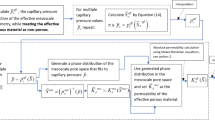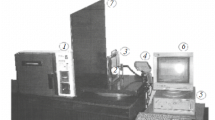Issues involved in drying and determining the porosity of yarn filaments are considered. A technique is proposed for the experimental determination of yarn filament porosity based on an analysis of their drying curves. An algorithm for the automated processing of the experimental results and subsequent determination of the apparent porosity of the yarn filaments is presented. The results of calculating the porosity of polyamide and viscose multifilaments are shown to be in good agreement with those predicted according to theory.
Similar content being viewed by others
Explore related subjects
Discover the latest articles, news and stories from top researchers in related subjects.Avoid common mistakes on your manuscript.
One of the most important characteristics of any textile component is its porosity. In determining the speed and completeness of impregnation and drying operations during the formation of composite materials, the porosity of a yarn filament thus defines the quality of finished product. In order to forecast formation modes and optimize technological processes, it is necessary to obtain accurate information regarding the porosity of a textile material.
While the accurate determination of a textile fiber material’s porosity remains a challenging task, a number of methods for accomplishing this are currently in use. These include: direct methods involving a determination of the total volume of a porous sample and the volume of the skeleton material without pores (pore volume = total volume minus the volume of material), optical methods (e.g., determining the area of the material depending on the area of pores visible under a microscope, since “planar” and “volume” types of porosity are the same for porous media having a random structure), computed tomography methods, absorption, water evaporation (pore volume = mass of saturated sample minus mass of dried sample/water density), mercury porosimetry, gas expansion, thermoporosimetry, and cryoporometry [1].
The following conclusions can be drawn from analyzing the applicability of the above methods for determining the porosity of yarns and multifilaments. While some methods require complex and expensive equipment (computed tomography, mercury porosimetry, gas expansion, thermoporosimetry, and cryoporometry), other methods do not provide sufficient accuracy for yarns and multifilaments (direct and optical methods). The liquid evaporation method often mentioned in the scientific literature turns to be problematic when applied to yarns and multifilaments: in addition to the filling of internal pores, a film is formed by the liquid on the surface of the material when impregnating the yarn, producing a significant error in the final result (the final porosity turns out to be more than 100%, which is illogical). Thus, in order to accurately determine the porosity of yarns and multifilaments, it is necessary either to determine the mass of the film on the surface and subtract it from the weight of the impregnated sample before calculating, or to somehow remove this film. Attempts to mechanically remove the liquid film from the surface of yarns or multifilaments are not easily reproducible. In this connection, evaporating the liquid film from the surface of the material seems to be a more controllable process. Since it is its surface that is in contact with the air environment, it is the film that evaporates first. The problem then arises of determining the moment when the liquid film will stop evaporating.
In order to determine the apparent porosity of fibrous materials, methods involving their immersion in a liquid to completely wet the fiber have been proposed [2]. The selection of benzene or ethyl alcohol is carried out on the basis of having a contact angle value close to zero. Then the calculation of the apparent porosity of fibrous materials can be carried out according to the formula
where Pap is the apparent porosity; Vmat is the volume of fiber material (m3); Vliq is the volume of absorbed liquid (m3).
Preliminary experimental studies have shown that difficulties arise when using this method due to the complexity of accurately determining the volume of absorbed liquid [3,4,5]. Therefore, in the present work, a new method for determining the porosity of yarns is proposed based on an analysis of its drying curves.
During drying, moisture on the surface of the textile material (so-called wetting moisture) is first evaporated. This stage corresponds to the linear section of the drying curve, i.e., the stage of constant drying velocity. Following the evaporation of wetting moisture, capillary moisture in the capillaries and pores of the textile material begins to evaporate. The drying velocity slows down as shown by the transition of the drying curve from a straight section to a curvilinear one – a stage of a decreasing drying velocity. At the moment of transition to the evaporation of capillary moisture, the volume of the liquid corresponds to the volume of the pores. Thus, the moisture content in the textile material at the time of transition of the drying curve from a constant to a decreasing velocity stage, referred to as the critical moisture content, roughly corresponds to the porosity of the textile material.
The novelty of the proposed method for determining porosity consists in the fact that the weighing of material pre-impregnated with liquid is performed simultaneously with its drying. From the obtained drying curve, the point of transition from a straight to a curvilinear section is determined by the regression analysis method. The volume of liquid in the textile is calculated at this moment in time. Then, the total volume of the textile is calculated. Consequently, the porosity is determined by the ratio of the volume of liquid to the total volume of the material.
Figure 1 shows a block diagram of an algorithm for determining the porosity of yarn filaments based on the results of measuring the mass of the material during the drying process.
On the basis of the above algorithm, the authors have developed a computer program for automated determination of the yarn filament porosity. In order to study the volume of pores capable of being filled with liquid during impregnation, filaments were used having properties as presented in the Table 1. To increase the wettability and achieve the maximum possible filling of the pore space with liquid, the filaments were preliminarily subjected to bucking to reduce the number of dead-end pores [6, 7]. The Table 1 shows the results of calculating the true porosity of the modeled fibrous material and the experimental determination of the apparent porosity of the filaments.
Based on the obtained data, the drying curves were constructed using the Maple mathematical software package, allowing the critical points corresponding to the apparent porosity of the filaments to be determined (Fig. 2).Fig. 2. Yarn filament drying curves and critical points (Σ): a), b) polyamide multifilament 195 and 380 tex, respectively; c), d) viscose multifilament 195 and 380 tex, respectively.
As a result of the analysis of the drying curves, the points of transition from the first drying stage (removal of wetting, i.e., mechanically bound moisture) to the second (removal of moisture from macro- and micropores) were obtained. Knowing the transition point and the material moisture content at this moment in time (Wcrit), the apparent porosity (in %) of the fibrous material was calculated using the formula
where Vwater is the volume of water in the capillaries and pores of the fibrous material corresponding to the critical moisture content Wcrit (cm3); V0 is the volume of dry sample (cm3).
Thus, the proposed method allows the porosity of yarn filaments to be determined with sufficient accuracy, in a short time, and without the use of sophisticated equipment.
References
T.G. Plachenov and S.D. Kolosentsev, Porometry [In Russian], Khimiya, Leningrad (1988).
S.S. Voyushchii, Physicochemical Bases of Permeation and Impregnation of Fibrous Systems with Aqueous Dispersions of Polymers [In Russian], Khimiya, Moscow (1969).
A.N. Bizyuk and N.N. Yasinskaya, Izv. Vuzov. Tekhnol. Leg. Prom-sti [In Russian], 37, No. 3, 10-14 (2017).
N.N. Yasinskaya, A.N. Bizyuk, and K.E. Razumeev, Izv. Vuzov. Tekhnol. Leg. Prom-sti [In Russian], No. 6(378), 273-277 (2018).
N.N. Yasinskaya, V.I. Ol’shanskii, and A.G. Kogan, Composite Textile Materials. Monograph [In Russian], VSTU, Vitebsk (2016).
N.N. Yasinskaya, V.I. Ol’shanskii, and A.G. Kogan, Heat Treatment in the Formation of Composite Textile Materials. Monograph [In Russian], VSTU, Vitebsk (2019).
O.N. Makhov, Kinetics of Cotton Fabric Impregnation and Increasing the Efficiency of the Process of Their Chemical Finishing. Diss. Cand. Sci. (Tech.) [In Russian], ISTU, Ivanovo (2002).
Author information
Authors and Affiliations
Corresponding author
Additional information
Translated from Khimicheskie Volokna, No. 6, pp. 54-57, November-December, 2020
Rights and permissions
About this article
Cite this article
Bizyuk, A., Yasinskaya, N. Development of a Method for the Experimental Study of the Capillary-Porous Structure of Yarn Filaments. Fibre Chem 52, 435–438 (2021). https://doi.org/10.1007/s10692-021-10227-9
Published:
Issue Date:
DOI: https://doi.org/10.1007/s10692-021-10227-9






